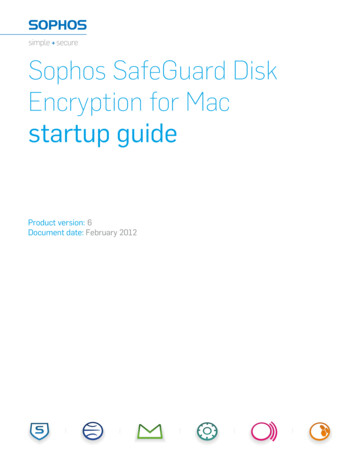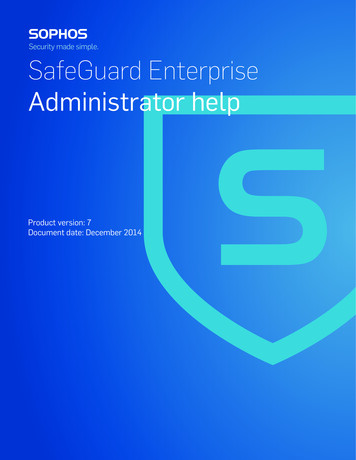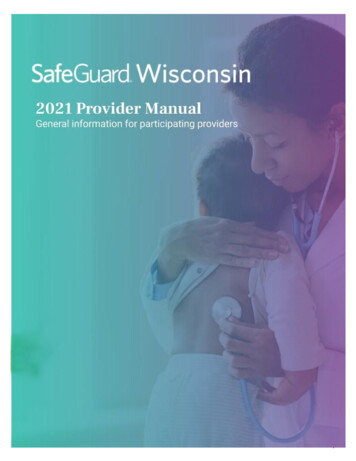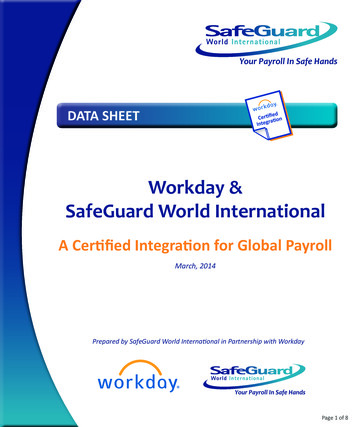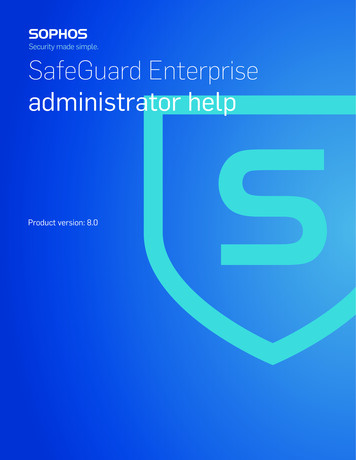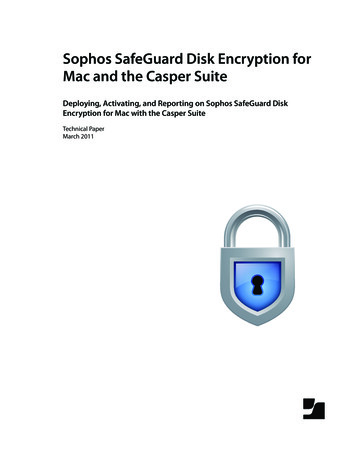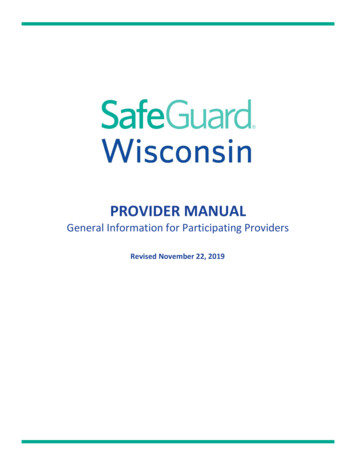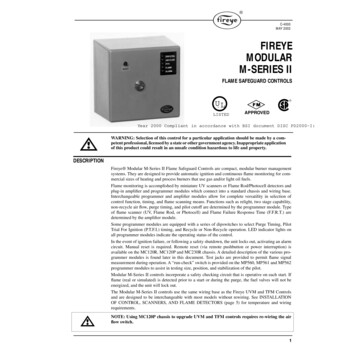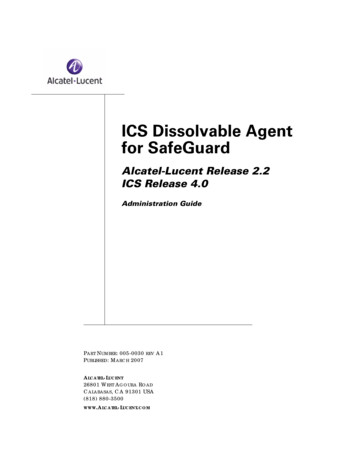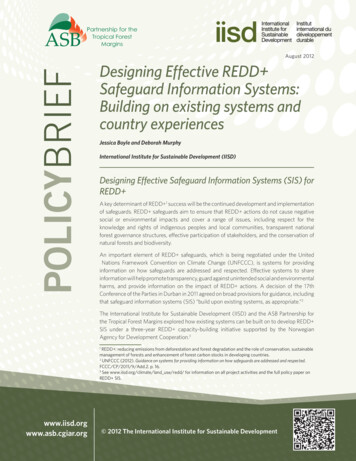
Transcription
August 2012Designing Effective REDD Safeguard Information Systems:Building on existing systems andcountry experiencesJessica Boyle and Deborah MurphyInternational Institute for Sustainable Development (IISD)Designing Effective Safeguard Information Systems (SIS) forREDD A key determinant of REDD 1 success will be the continued development and implementationof safeguards. REDD safeguards aim to ensure that REDD actions do not cause negativesocial or environmental impacts and cover a range of issues, including respect for theknowledge and rights of indigenous peoples and local communities, transparent nationalforest governance structures, effective participation of stakeholders, and the conservation ofnatural forests and biodiversity.An important element of REDD safeguards, which is being negotiated under the UnitedNations Framework Convention on Climate Change (UNFCCC), is systems for providinginformation on how safeguards are addressed and respected. Effective systems to shareinformation will help promote transparency, guard against unintended social and environmentalharms, and provide information on the impact of REDD actions. A decision of the 17thConference of the Parties in Durban in 2011 agreed on broad provisions for guidance, includingthat safeguard information systems (SIS) “build upon existing systems, as appropriate.”2The International Institute for Sustainable Development (IISD) and the ASB Partnership forthe Tropical Forest Margins explored how existing systems can be built on to develop REDD SIS under a three-year REDD capacity-building initiative supported by the NorwegianAgency for Development Cooperation.3REDD : reducing emissions from deforestation and forest degradation and the role of conservation, sustainablemanagement of forests and enhancement of forest carbon stocks in developing countries.2UNFCCC (2012). Guidance on systems for providing information on how safeguards are addressed and respected.FCCC/CP/2011/9/Add.2. p. 16.3See www.iisd.org/climate/land use/redd/ for information on all project activities and the full policy paper onREDD SIS.1www.iisd.orgwww.asb.cgiar.org 2012 The International Institute for Sustainable Development
Using the Durban guidance on safeguards as a starting point, and drawing on information gathered through expertmeetings and interviews with over 50 developing country REDD decision-makers and implementers, the researchexamined: Information collected through eight existing systems that could feed into reporting on REDD safeguards. How the existing systems ensure transparency, consistency, accessibility, flexibility, country-driven processesand the lessons for a REDD SIS. Early action in five countries—Ethiopia, Indonesia, the Philippines, Tanzania and Vietnam—to provide lessonsand insights for the further development of REDD SIS.In exploring these key areas, this research aims to contribute to improved REDD SIS by identifying how REDD practitioners can build on existing systems and learn from early action. The complete analysis is available in the policypaper, Designing Effective REDD Safeguard Information Systems: Building on Existing Systems and Country Experiences.Building on Existing ProcessesA host of existing systems can be built upon in the development and implementation of REDD SIS. Eight existingprocesses were examined, looking at the information collected relative to the REDD safeguards, as well as lessonsfor meeting the Durban guidance of ensuring transparency, consistency, accessibility, flexibility and country-drivenprocesses. The eight processes analyzed were: Social and Environmental Principles and Criteria (SEPC) of the UN-REDD Programme Strategic Environmental and Social Assessment (SESA) and Environmental and Social Management Framework(ESMF), Forest Carbon Partnership Facility (FCPF) REDD Social and Environmental Standards (REDD SES), CARE International and the Climate, Communityand Biodiversity Alliance (CCBA) Convention on Biological Diversity (CBD) United Nations Declaration on the Rights of Indigenous Peoples (UNDRIP) and Free, Prior and InformedConsent (FPIC) Global Forest Resources Assessment (FRA) Forest Stewardship Council (FSC) Principles and Criteria Forest Law Enforcement, Governance and Trade (FLEGT)Information CollectedThese processes collect and analyze information that has particular relevance for reporting on the seven REDD safeguards set out in the Cancun Agreements. Research findings include: The UN-REDD SEPC and CCBA REDD SES collect information that is applicable to most of the REDD safeguards. These two processes are most closely aligned to the REDD safeguards and with appropriate andfocused planning and coordination; with them, countries could collect information that would meet the needsof reporting on both REDD safeguards and the UN-REDD or CCBA process.www.iisd.org 2012 The International Institute for Sustainable Developmentwww.asb.cgiar.orgPOLICY BRIEF AUGUST 2012Designing Effective REDD Safeguard Information Systems: Building on existing systems and country experiences2
The FLEGT process is especially strong on the governance safeguards (a) and (b), providing information onnational forest laws, policies, regulations and programs; the effectiveness of legal frameworks and gaps; andbarriers and challenges to their implementation. Countries could build on their FLEGT analysis to determinewhich policies, laws and programs help to implement safeguards. Countries with FPIC processes may have reporting processes in place relevant to safeguard (c), respect forknowledge of indigenous peoples. The World Bank principles also address respect for indigenous peoples, andthis reporting could pertain to the REDD safeguard. Stakeholder participation is an important element in most processes, and many of the processes may provideinformation on safeguard (d). Countries may consider reporting on this participation, or use the reporting asan example. Countries could also consider using established stakeholder processes to collect information onsafeguards. The CBD provides information on biodiversity that is applicable to reporting on safeguard (e). Countries maybe able to directly use information reported to the CBD to provide information on the REDD biodiversitysafeguard. The Forest Resource Assessments provide information related to safeguard (e). FRA information may helpcountries report on the state of natural forests and biodiversity. The CBD’s reporting on the loss of naturalhabitat may also provide information on permanence at the national level—safeguard (f); and possibly on theleakage safeguard (g) at the national level. The FSC information tends to be at the level of a specific forest and is not as applicable to REDD safeguardreporting as the other processes.The REDD safeguards and those existing systems that collect information relevant to safeguards are summarized inTable 1 below.TABLE 1: SUMMARY OF INFORMATION ON REDD SAFEGUARDS WITHIN EXISTING SYSTEMSREDD SAFEGUARDEXISTING PROCESSUN-REDD SEPCAND BERTFCPF SESAAND ESMFCCBAREDD SESCBDUNDRIPAND FPICFRAFLEGT (a) Consistency with existing laws (b) Transparent governance andsovereignty (c) Respect for knowledge ofindigenous people, UNDRIP (d) Full and effective participation ofstakeholders (e) Conservation, biological diversityand enhancement of benefits (f) Address risk of reversals (g) Reduce displacement of emissions FSC P&C www.iisd.org 2012 The International Institute for Sustainable Developmentwww.asb.cgiar.orgPOLICY BRIEF AUGUST 2012Designing Effective REDD Safeguard Information Systems: Building on existing systems and country experiences3
Addressing the Principles in the Durban GuidanceThese existing systems also provide lessons on how to address the principles set out in the Durban guidance:transparency, consistency, accessibility, flexibility and country-driven, as discussed below. Transparency – Information needs to be collected using broad multistakeholder processes. Validation is animportant element of transparency, with some processes using national experts and others using national andinternational. It is important to use country experts to compile safeguards information. Consistency – Setting timelines for reporting can help ensure consistency and comparability across countries,and across years within countries. For example, reporting to the CBD takes place every four years with thenext reports due in 2014; and the next FRA reports will be delivered in 2015. The FCPF ESMF requires annualmonitoring report. Common reporting frameworks and tools can help with the collection of information thatis comparable and consistent across countries, such as the resource manual (CBD), common questionnaire(FRA), and the Benefits and Risk Tool (BeRT) tool (UN-REDD SEPC). The CCBA SES use common internationalstandards, for which countries develop nationally specific indicators; Voluntary Partnership Agreements(VPAs) have a similar general framework. Accessibility – Information should be made publicly available in an accessible manner (which also contributesto transparency). Most processes use online portals or databases to make information available. Availability inlocal languages can help increase accessibility. Flexibility – Processes evolve and improve as lessons are learned. Some processes have changed theirindicators (FRA, ESMF, CBD, FSC) as knowledge has improved and monitoring processes have adopted newmethodologies. Country-driven processes – All processes encourage country-driven processes. This often includes a generalframework that is consistent across countries, with flexibility to develop country-specific details, indicators,reporting and monitoring processes. The UN-REDD SEPC and the CCBA SES have developed internationalstandards and principles, with country-specific interpretation of specific indicators. Country-level expertsundertake the FRA data collection and validation, and ESMF are country-specific based on the nationalSESA process. FLEGT VPAs reflect a country’s legal and institutional foundations to develop country-specificagreements (that follow a general framework across countries).Learning from Early ActionEarly experiences in developing systems for reporting on REDD safeguards provide important insights. Somecountries are beginning to establish formal or informal bodies that are tasked with developing a REDD SIS withinthe national REDD planning processes. Other countries are undertaking a more piecemeal approach, with individualactors, governments, departments or civil society groups (CSOs) working toward the elaboration of a REDD SIS.The main lessons learned from early experiences in Ethiopia, Indonesia, the Philippines, Tanzania and Vietnam arediscussed below.www.iisd.org 2012 The International Institute for Sustainable Developmentwww.asb.cgiar.orgPOLICY BRIEF AUGUST 2012Designing Effective REDD Safeguard Information Systems: Building on existing systems and country experiences4
REDD information systems are building on existing systems – The Philippines is using data from its FRA toinform its safeguards reporting, as well as using biodiversity assessments established for other processes. ThePhilippines is also considering harmonizing its international safeguards reporting requirements with that ofbilateral donors. Tanzania is exploring the safeguard reporting requirements under UN-REDD, FCPF and CCBASES to identify national safeguards and reporting information. Vietnam’s REDD SIS Sub-Technical WorkingGroup is looking at existing REDD systems—such as the national REDD measurement, reporting andverification (MRV) framework, REDD benefits distribution system, forest management information system,UN-REDD’S Participatory Governance Assessment and FPIC experiences—for linkages with REDD safeguardsreporting. Tools and reporting processes developed at the activity level in Tanzania and the Philippines arebeing explored for their applicability to national REDD safeguard reporting. Institutional structures for REDD safeguards reporting can build on existing structures – Indonesia’s NationalCouncil on Climate Change envisions an institutional setting for its REDD SIS that builds on existing relevantREDD authorities at the subnational and national levels. Most countries consider REDD focal points as thelogical entity for reporting to the UNFCCC, being that they are well placed to access and coordinate informationusing existing lines of communication. Institutional structures can facilitate feeding information up into a national REDD information system –Indonesia has evolved data collection to the provincial level, with the national focal point rolling up informationand reporting internationally. Tanzania has institutional processes in place that allow CSOs and REDD projectimplementers to feed information on REDD projects to the national level, and are exploring using theseavenues for conveying safeguard information. The project-level MRV system in the Philippines that assessesemissions and safeguards is providing lessons and input to the national level. Stakeholder participation is central to REDD success – All countries stressed the importance of stakeholderprocesses to provide and validate REDD safeguard information. Ethiopia, informed by Participatory ForestManagement experiences, stresses the importance of community-level involvement in safeguard reporting,including data collection, monitoring and measurement. The Philippines’ experience shows the importance ofstakeholders, particularly CSOs, in filling capacity gaps. Indonesia’s institutional structure includes a board ofmultistakeholders, and Tanzania and Vietnam’s work to develop an SIS has included multistakeholder workinggroups. International guidance is needed, but country-driven processes are critical – International guidance is neededto assist countries in safeguard reporting, and could include guidance documents and reporting frameworks.This international guidance must recognize that countries have varied levels of information on REDD andforests and different capacities to collect, monitor and report on safeguards. The information and capacity willimprove, but early reporting requirements should respect the situation at the country level and not add largeburdens or impose requirements that will require the use of international consultants. The aim should be tobuild on and improve existing in-country capacity. Safeguard reporting needs to consider how benefits flow to local communities – REDD success will belargely dependent on benefits flowing to local communities and safeguard reporting should address this. CSOsare considering how Vietnam’s work on a benefits distribution system could be linked to the REDD SIS.www.iisd.org 2012 The International Institute for Sustainable Developmentwww.asb.cgiar.orgPOLICY BRIEF AUGUST 2012Designing Effective REDD Safeguard Information Systems: Building on existing systems and country experiences5
Issues for Consideration by REDD Negotiators, Policy-Makers andPractitionersDiscussions on a system for providing information on how REDD safeguards are addressed and respected will continuein the lead up to and at COP 18 in Doha, Qatar. This research shows that countries can build on existing processes indeveloping their REDD SIS, consistent with the Durban guidance. Issues for consideration by REDD negotiators,policy-makers and practitioners as they move forward to build on the Durban guidance are discussed below.Harmonize REDD Safeguard Reporting RequirementsA unified REDD safeguard reporting framework (collection, reporting and verification) is needed that meets therequirements of the UNFCCC as well as funders of REDD activities. REDD countries are involved in numerousprocesses related to safeguards at the national and subnational levels. These include processes imposed byfunders, voluntary standards and national systems. Examples include the FCPF, UN-REDD Programme’s Social andEnvironmental Principles and Criteria, and the REDD Social and Environmental Standards of the CARE Internationaland the Climate, Community and Biodiversity Alliance, which collect information on issues included in the UNFCCCsafeguards. Reporting on REDD safeguards to multiple authorities with different requirements introduces unnecessarycomplexities and could mean that REDD focal points are faced with competing demands from various processes.Many of these initiatives are at an early stage of development, offering an opportunity to align information needs in thevarious processes.Coordinate Collection of REDD Safeguard Information with Other ProcessesOver the next two to three years, countries will be developing reports for the Convention of Biological Diversity(CBD) and the Global Forest Resource Assessment (FRA), and coordination with these processes is needed toensure coherence and prevent duplication of effort. Various processes, such as the CBD and the FRA, collect couldinformation that could be used to report on addressing and respecting REDD safeguards. For example, reportingprocesses under the CBD collect information on biodiversity and natural forests, and the FRA collects information onnatural forest conversion and biodiversity. In addition, countries that have developed legality matrices under FLEGTagreements have gathered information on national forest governance structures.Provide International GuidanceUnder the UNFCCC, a draft reporting template and draft online database should be developed to provide guidanceto developing countries; the UN-REDD Programme’s Benefits and Risk Tool could be applicable for reportinginternationally. REDD policy-makers and practitioners have expressed the need for international guidance onsafeguard reporting, providing further clarity around minimum standards or thresholds for REDD SIS. This couldinclude a reporting template, checklist or guiding questions.www.iisd.org 2012 The International Institute for Sustainable Developmentwww.asb.cgiar.orgPOLICY BRIEF AUGUST 2012Designing Effective REDD Safeguard Information Systems: Building on existing systems and country experiences6
Ensure REDD Safeguards Reporting is Country-Driven and Country-AppropriateFuture guidance on REDD safeguard reporting needs to be sufficiently flexible, and should aim to build on andimprove existing in-country capacity. While international guidance is needed, REDD SIS must be country-driven andsensitive to national circumstances. Countries have varied levels of information on REDD and forests, and differentcapacities to collect, monitor and report on safeguards. The information and capacity will improve as REDD programsare implemented, but early reporting requirements should respect the situation at the country level.Use Existing Stakeholder Processes where PossibleGiven in-country capacity concerns, safeguard reporting processes need to be imbedded in stakeholder processesestablished for existing systems. For example, many of the same government authorities, stakeholder groups andprivate sector actors have an interest in both FLEGT and REDD . The stakeholder groups established for other REDD processes could be the basis on which to build an appropriate stakeholder group to guide the development of aninformation system for reporting on how REDD safeguards are addressed and respected. Critical stakeholders in otherprocesses, such as the CBD and FRA, could be brought into the REDD SIS working groups to facilitate informationsharing.Provide Financial and Capacity-Building SupportFinancing for capacity building should be a short-term priority. Many developing countries require internationalfinancial and capacity-building support to develop effective systems to provide information on how REDD safeguardsare addressed and respected.Disseminate Lessons Learned and Tools DevelopedCountries are establishing institutions and processes for reporting on REDD safeguards and there is a need forsharing information and lessons learned. Workshops under the UNFCCC are one way to share country experiences.Another option is workshops supported by groups not linked to the negotiations, such as the series of REDD expertsmeetings held by IISD and the ASB Partnership at the Tropical Forest Margins with support of the Government ofNorway. Country representatives often are able to speak more frankly about experiences in less formal, non-negotiationsessions. Furthermore, a systematic assessment of the applicability and usefulness of REDD tools and methods isneeded across the REDD value chain. In this respect, there is a need and desire for continued dialogue to address thevarious concerns and needs of governments, the private sector and civil society.www.iisd.org 2012 The International Institute for Sustainable Developmentwww.asb.cgiar.orgPOLICY BRIEF AUGUST 2012Designing Effective REDD Safeguard Information Systems: Building on existing systems and country experiences7
Published by the International Institute for Sustainable Development.International Institute for Sustainable DevelopmentHead Office161 Portage Avenue East, 6th Floor, Winnipeg, Manitoba, Canada R3B 0Y4Tel: 1 (204) 958-7700 Fax: 1 (204) 958-7710 Web site: www.iisd.orgAbout IISDThe International Institute for Sustainable Development (IISD) contributes to sustainable development by advancingpolicy recommendations on international trade and investment, economic policy, climate change and energy, andmanagement of natural and social capital, as well as the enabling role of communication technologies in these areas.We report on international negotiations and disseminate knowledge gained through collaborative projects, resulting inmore rigorous research, capacity building in developing countries, better networks spanning the North and the South,and better global connections among researchers, practitioners, citizens and policy-makers.IISD’s vision is better living for all—sustainably; its mission is to champion innovation, enabling societies to livesustainably. IISD is registered as a charitable organization in Canada and has 501(c)(3) status in the United States.IISD receives core operating support from the Government of Canada, provided through the Canadian InternationalDevelopment Agency (CIDA), the International Development Research Centre (IDRC), and from the Province ofManitoba. The Institute receives project funding from numerous governments inside and outside Canada, UnitedNations agencies, foundations and the private sector.About ASB Partnership for the Tropical Forest MarginsFounded in 1994 as a program on Alternatives to Slash and Burn (ASB), the ASB Partnership for the Tropical ForestMargins has evolved into a global partnership that brings together local knowledge, policy perspectives and science tounderstand the tradeoffs associated with different land uses and the roles of markets, regulation, property rights andrewards. While ASB is coordinated by the World Agroforestry Centre (ICRAF), it is a global partnership of internationaland national-level research institutes, non-governmental organizations, universities, community organizations, farmers’groups and other local, national and international organizations. Our goal is to raise productivity and income of ruralhouseholds in the humid tropics without increasing deforestation or undermining essential environmental services.www.iisd.orgwww.asb.cgiar.org 2012 The International Institute for Sustainable Development
reporting and monitoring processes. The UN-REDD SEPC and the CCBA SES have developed international standards and principles, with country-specific interpretation of specific indicators. Country-level experts undertake the FRA data collection and validation, and ESMF are country-specific based on the national SESA process.
